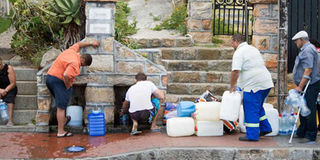Africa’s cities are growing larger and thirstier

This file photo taken on January 19, 2018 shows people collecting drinking water from pipes fed by an underground spring, in St James, about 25km from the city centre in Cape Town. City officials have announced that Cape Town is likely to go absolutely dry on April 12. PHOTO | RODGER BOSCH | AFP
What you need to know:
- Global warming is becoming a real threat to Africa’s economic growth and human survival.
- Air pollution is becoming a central challenge to development, and specifically to Africa’s industrialisation.
In two months, the city of Cape Town in South Africa could become the first major metropolis in the world to run out of water.
City officials have announced that Cape Town is likely to go absolutely dry on April 12.
The city has been hit by nearly three consecutive years of drought.
Cape Town’s unfolding tragedy is just but a sign of the chickens coming home to roost for Africa after decades of population growth and rapid urbanisation.
From Nairobi to Lagos and Windhoek, Dar es Salaam to Dakar, African cities are growing larger and dryer.
GLOBAL WARMING
We should be afraid, very afraid, when development yields despair instead of cheer.
Researchers warn 2017 was the hottest year on record and global warming is becoming a real threat to Africa’s economic growth and human survival.
Kenya’s capital city is struggling under the heavy burden of rapid urbanisation.
This has had varying effects, including the proliferation of congested informal dwellings, population explosion, unemployment and insecurity.
WATER SHORTAGE
The warming city has also had its fair share of water challenges.
Long divided along economic lines, Nairobi is today united by an ubiquitous water shortage.
Dry taps are now the norm in upmarket Muthaiga, Kileleshwa and Westlands as it is in Dandora, Donholm, Buruburu and Nyayo estates.
The Nairobi Water Company has enforced a strict water rationing programme after Ndakaini Dam water levels failed to recover last year.
The dip came as a result of a prolonged national drought that exposed millions of Kenyans to severe famine.
HEALTH
In many parts of Kenya, rain does not come in season as it used to, thanks in part to massive deforestation and the destruction of water towers.
The effect has been that the country and its capital are literally drying up.
Evidence shows that changes in temperature have affected the health, livelihoods, food productivity, water availability, and overall security of the African people.
Other disasters such as flooding, drought, change in distribution of rainfall, drying up of rivers, melting of glaciers, and the receding of bodies of water are becoming more frequent around the continent.
Our continent is also losing many of its natural resources to habitat destruction driven by land use change for economic development.
WILDLIFE
Our signature wildlife, the big five, are endangered. We are losing 20,000 elephants every year out of a herd of 475,000.
In 20 years this beautiful giant risks becoming extinct.
In 10 years, the population of lions has fallen from 50,000 in 2005 to 23,000 today, while rhinos are on the brink of extinction.
These statistics are shocking, especially if we consider the impact on the natural capital of Africa and related services such as tourism, which is the spine of many African economies.
In the meantime, air pollution is becoming a central challenge to development, and specifically to Africa’s industrialisation.
The invisible killer claims about 700,000 Africans every year.
AIR POLLUTION
With 23 per cent of global deaths (12.6 million) linked to environmental factors, the World Health Organization estimates that air pollution is responsible for seven million deaths every year.
Air pollution is caused by harmful particles and gases, released in high quantities into the air.
These pollutants cause disease and death to humans, damage to other living organisms such as animals and food crops, and harm our ecosystems.
Yet despair, death and disease shouldn’t be the inevitable consequences of the continent’s development trajectory.
We are the luckiest and most prosperous generation of Africans ever to walk the earth.
TECHNOLOGY
We are healthier and living longer than our forefathers. Our life expectancy has risen; we have conquered the skies and excelled at technological innovations.
There are 24 African dollar billionaires with a total worth of $80.96 billion.
These men and women are richer than many African countries – Kenya has a GDP of $63 billion, Ethiopia $62 billion and Tanzania $45 billion.
We have produced business leaders and two UN Secretaries-General.
Our sportsmen and women have conquered the world and the continent is generally on the rise.
ATTITUDE CHANGE
Even the Economist magazine, which once dismissed Africa as the home of the wretched, recognizes that Africa is on the rise.
All this suggests that Africa has the skills, the resources and the technology to avoid the worst impacts of climate change and economic development.
We have the aptitude to do the right thing, the challenge is how fast we can reconfigure our attitude to seize the opportunity before it’s too late.
Our legacy can’t — and shouldn’t — be death and destruction.
Africa needs a serious conservation conversation with itself because the development decisions we make today will determine the kind of a continent we’ll leave for our grandchildren.
If we continue razing our forests and developing every last inch of our savannas, our children will inherit an Africa with declining air quality, growing water insecurity, depleted food resources, fighting over resources and other negative consequences.
That can’t be our present to posterity!
Mr Sebunya is president of the African Wildlife Foundation. [email protected]




